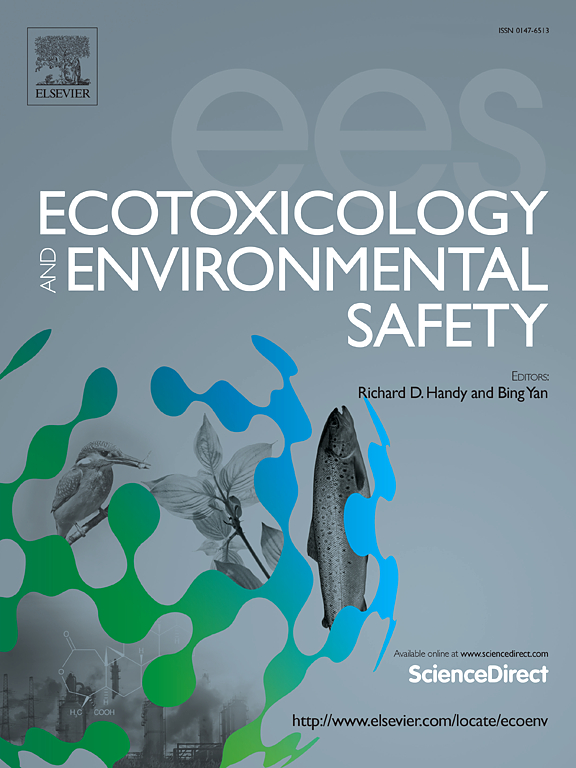通过使用时间活动日记和尿液生物监测进行为期7天的全面调查,探索被忽视的双酚暴露源
IF 6.1
2区 环境科学与生态学
Q1 ENVIRONMENTAL SCIENCES
引用次数: 0
摘要
双酚广泛用于聚碳酸酯塑料和环氧树脂中,与潜在的健康风险有关,但许多接触源仍未充分表征。本研究采用了一种新颖的方法,将7天时间活动日记与个体化尿液生物监测相结合,以捕捉被忽视的BP暴露源。12名成年参与者仔细记录了他们连续7天的日常活动,包括食物摄入,同时提供了所有的尿量供分析。共收集并单独分析401份尿液样本(未合并),以评估时间变化和暴露相关性。在分析的8种bp中,双酚A (BPA)和双酚S (BPs)的检出率超过70 %,中位数浓度范围从低于定量限(LOQ)的BPA到1.46 ng/mL, BPs的LOQ到0.85 ng/mL,突出了广泛的暴露。虽然一般的问卷调查提供的信息有限,但多天的日记成功地将BP暴露与两个众所周知的来源联系起来,如食品容器、个人护理产品、洗涤剂和收据,以及以前未被探索的来源,包括药膏、医用膏药、透明紧身衣、墙纸、乙烯基地板装置、作物种植和带手套的食物准备。这些发现表明,将详细的、多日的活动跟踪与个性化的生物监测相结合,可以发现微妙的、非常规的化学暴露途径。未来在更大人群中的调查有必要完善暴露评估策略并更好地了解BP暴露动力学。本文章由计算机程序翻译,如有差异,请以英文原文为准。
Exploring overlooked bisphenol exposure sources through a comprehensive 7-day investigation using time-activity diaries and urinary biomonitoring
Bisphenols (BPs), widely used in polycarbonate plastics and epoxy resins, are associated with potential health risks, yet many exposure sources remain inadequately characterized. This study employed a novel approach by integrating 7-day time-activity diaries with individualized urinary biomonitoring to capture overlooked BP exposure sources. Twelve adult participants meticulously documented their daily activities, including food intake, across seven consecutive days, while providing all urine voids for analysis. A total of 401 urine samples were collected and analyzed individually (without pooling) to assess temporal variations and exposure associations. Among the eight analyzed BPs, Bisphenol A (BPA) and Bisphenol S (BPS) were detected in over 70 %, with median concentrations ranging from below the limit of quantification (LOQ) to 1.46 ng/mL for BPA and <LOQ to 0.85 ng/mL for BPS, highlighting widespread exposure. While general questionnaires provided limited insight, the multi-day diaries successfully linked BP exposure to both well-known sources-such as food containers, personal care products, detergents, and receipts-and previously underexplored sources, including ointments, medical plasters, sheer tights, wallpapering, vinyl flooring installation, crop cultivation, and food preparation with gloves. These findings demonstrate the power of combining detailed, multi-day activity tracking with individualized biomonitoring to uncover subtle and unconventional chemical exposure routes. Future investigations in larger populations are warranted to refine exposure assessment strategies and better understand BP exposure dynamics.
求助全文
通过发布文献求助,成功后即可免费获取论文全文。
去求助
来源期刊
CiteScore
12.10
自引率
5.90%
发文量
1234
审稿时长
88 days
期刊介绍:
Ecotoxicology and Environmental Safety is a multi-disciplinary journal that focuses on understanding the exposure and effects of environmental contamination on organisms including human health. The scope of the journal covers three main themes. The topics within these themes, indicated below, include (but are not limited to) the following: Ecotoxicology、Environmental Chemistry、Environmental Safety etc.

 求助内容:
求助内容: 应助结果提醒方式:
应助结果提醒方式:


